Provins, Town of Medieval Fairs: During the Middle Ages, the fairs of Provins and three other towns in the Champagne region were the most famous of the medieval fairs in the whole of Europe. The fairs developed from local markets to regional markets and later to markets of Europe-wide importance. Provins linked the trade routes between the Low Countries, consisting of Belgium, Luxembourg and the Netherlands, and Scandinavia with the Meditarranean world, especially Northern Italy. Due to the Champagne fairs, Provins became a wealthy, commercial trading town. Products from throughout Europe and the Far East were traded in Provins, such as wool and fur from Scandinavia, textiles from the Netherlands, cloth from Flanders, leather from Spain, and sugar, cotton, spices and silk from the Far East. The decline of the Champagne fairs started in the beginning of the 14th century, when the Champagne region became a part of France. Their place was assumed by the fairs of Geneva, Lyon and the Hanseatic towns of Brugge and Cologne. Provins has still preserved its medieval architecture, among them the Caesar's tower, town walls, including two gates and 22 towers and the Saint-Quiriace Collegiate Church. On her return of the coronation of Charles VII in Reims, Joan of Arc visited the church in 1429. The oldest inn of France is located in Provins. Provins is situated about 95 km southeast of Paris. Provins, Town of Medieval Fairs, was declared a UNESCO World Heritage in 2001.
www.werelderfgoedfotos.nl © Copyright World Heritage Photos

Provins, Town of Medieval Fairs: The 13th century town walls. Provins was one of the towns in the territory of the Counts of Champagne, that became a location for the great annual fairs. In the Middle Ages, merchants from all over Europe came here to buy and trade products such as textile, leather, fur, wool, linen cloth, silk and spices. Provins, Town of Medieval Fairs, was added to the UNESCO World Heritage List in 2001.
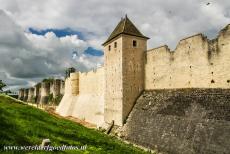
Provins, Town of Medieval Fairs: The 13th century town walls. Provins was one of the towns in the territory of the Counts of Champagne, that became a location for the great annual fairs. In the Middle Ages, merchants from all over Europe came here to buy and trade products such as textile, leather, fur, wool, linen cloth, silk and spices. Provins, Town of Medieval Fairs, was added to the UNESCO World Heritage List in 2001.
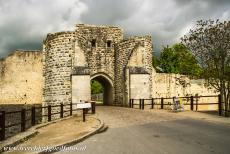
Provins, Town of Medieval Fairs: The Saint-Jean's Gate. The purpose of the Saint-Jean's Gate was to ensure the protection of the road to Paris. The fortified walls were built in the 13th century. Provins is still surrounded by fortified walls on three sides. The walls between the Jouy Gate and the Saint-Jean's Gate are the most interesting and complete parts of the ramparts. It is possible to take a walk on the walls.

Provins, Town of Medieval Fairs: The Jouy Gate was erected in the 13th century. The gate opens onto the road leading to the Cistercian Abbey of Jouy from which it gets its name. This road was the most important trade route, merchants traveled on this road to and from the fairs of Lagny, Troyes, Bar-sur-Aube and Provins. Provins linked numerous trade routes between the northern and southern regions of Europe.
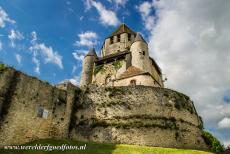
Provins, Town of Medieval Fairs: The Caesar's Tower is one of the most iconic symbols of the town of Provins. Built on a hill, the tower symbolises the power and authority of the Counts of Champagne over Provins and the region. The Caesar's Tower is the only known example of an octagonal keep built on a square bases. It was used as a watch tower and a prison. Since 1689, the tower houses the bells of the Saint-Quiriace Collegiate Church.

Provins, Town of Medieval Fairs: The Caesar's tower rises above the houses of Provins. Provins is one of the best preserved medieval cities in France. Every streetcorner recalls the splendor of Provins during the Middle Ages. During the Middle Ages, the fairs of Provins became the most important of Europe. Provins was once one of the first financial markets in Europe. Due to the fairs, Provins became a very wealthy and commercial trading town.

Provins, Town of Medieval Fairs: La Place de Châtel is a square and the centre of the medieval town. In the centre of the square stands an ancient water well and the 13th century Exchange Cross, here financial transactions were made. It was also called the 'Cross of Edicts' because it was used as a public notice board for the proclamations of the Counts of Champagne and later for those of the King of France.
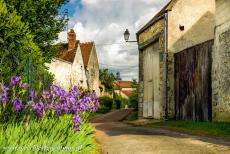
Provins, Town of Medieval Fairs: One of the pittoresque streets in the old town of Provins. The slow disappearance of the fairs, as well as the joining of the historic Champagne region to the Kingdom of France, led to the decline of Provins. Provins returned to being a small rural town, surrounded by open fields. It is now a well preserved medieval town with 58 great monuments. Provins, Town of Medieval Fairs gained the status as a UNESCO World Heritage in 2001.

Provins, Town of Medieval Fairs: The 'Maison Romane', the Romanesque House, is one of the oldest examples of civilian architecture in Provins. The Romanesque House was built in the 11th century and was probably the local synagogue, situated in the former Jewish Quarter. Today, it houses the Provins and Provins Area Museum. Most of the buildings of Provins dates from the 12th and 13th centuries.
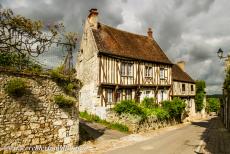
Provins, Town of Medieval Fairs: A pittoresque half-timbered house in one of the historic streets of Provins. During the Middle Ages, Provins was a major trade centre, the merchants came from all over Europe to sell their products. Nowdays, the town of Provins organizes medieval-themed fairs during Spring and Summer, and also during the Christmas time.

Provins, Town of Medieval Fairs: A characteristic of all the medieval buildings in Provins are the vaulted cellars, dating from the 12th to the 14th century. The Tithe Barn was used as an indoor marketplace. People came here to sell or to buy goods. It was only in the 12th century, that the Tithe Barn was used for storing taxes, caled the 'tithes', which were collected from the harvests.
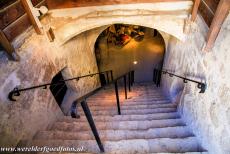
Provins, Town of Medieval Fairs: The entrance into the 'Grange aux Dîmes', the medieval indoor marketplace. Today, it is a museum that recalls the times of the medieval merchants who sold their goods here. The Tithe Barn, the French name 'Grange aux Dîmes', plays an important role in the book Foucault's Pendulum by the Italian writer Umberto Eco.

Provins, Town of Medieval Fairs: The disappearance of the fairs, as well as the joining of the Champagne region to the kingdom of France, led to the decline of Provins. Provins returned to being a small town. Now, Provins is one of the most beautiful medieval towns in France and is also a UNESCO World Heritage, surrounded by vibrant yellow rapeseed fields (Brassica napus).
